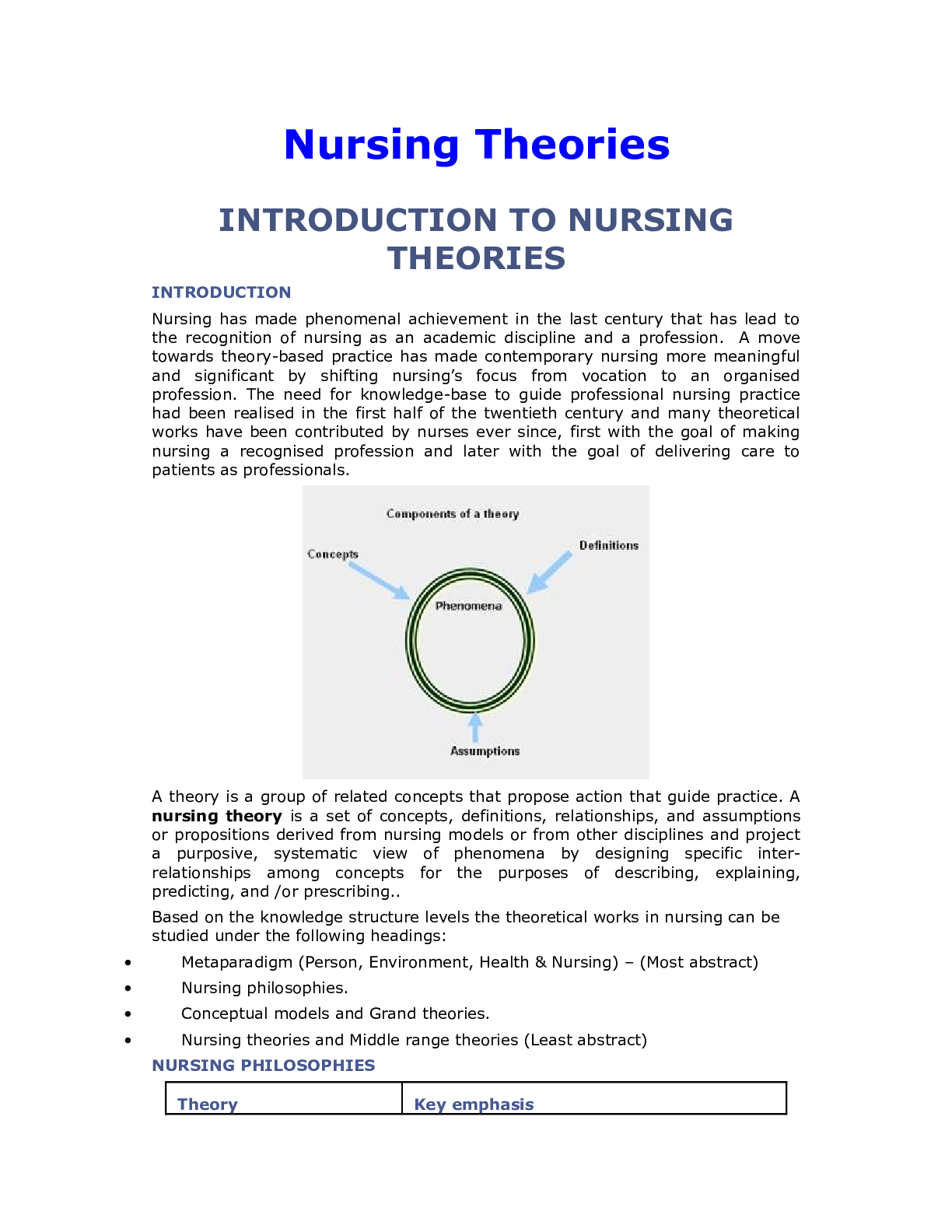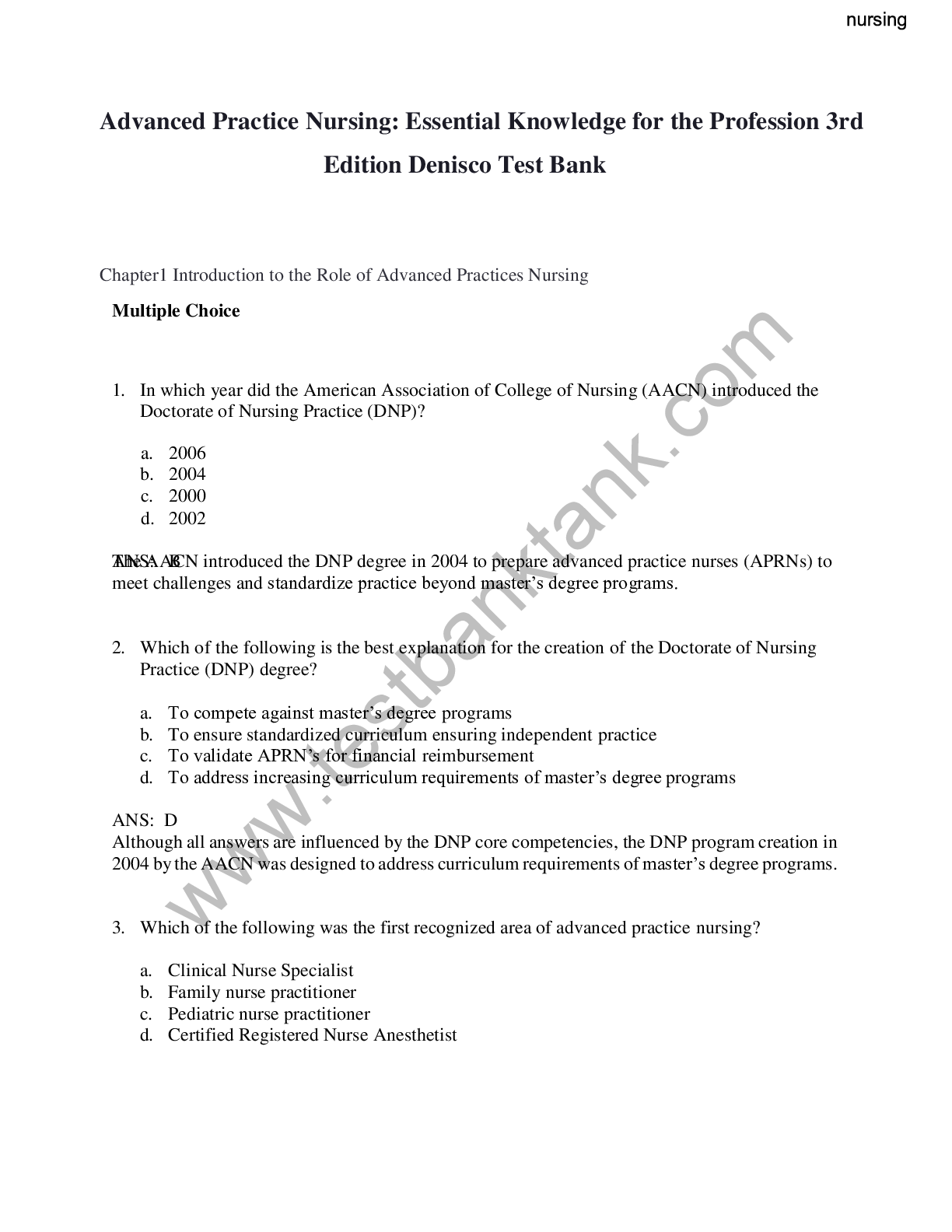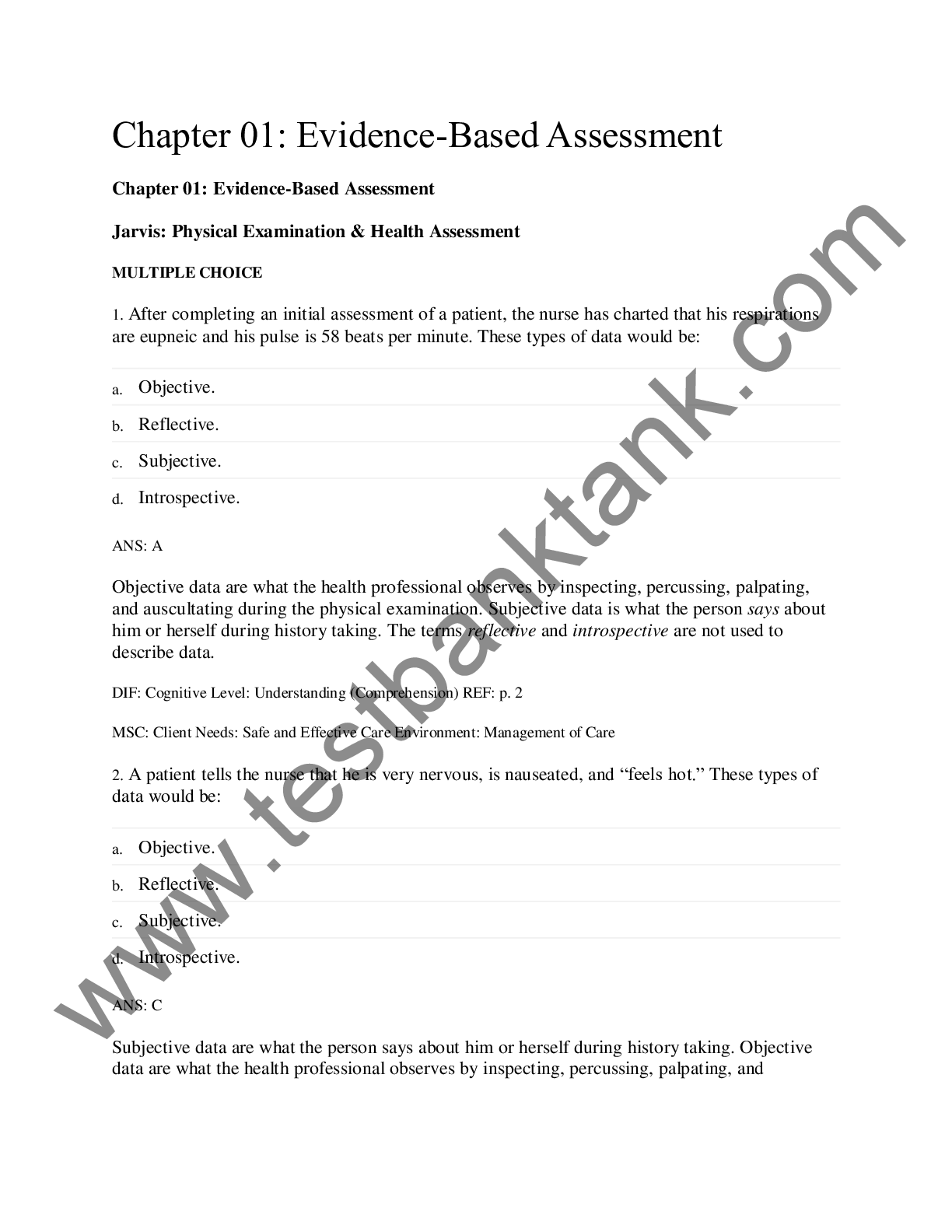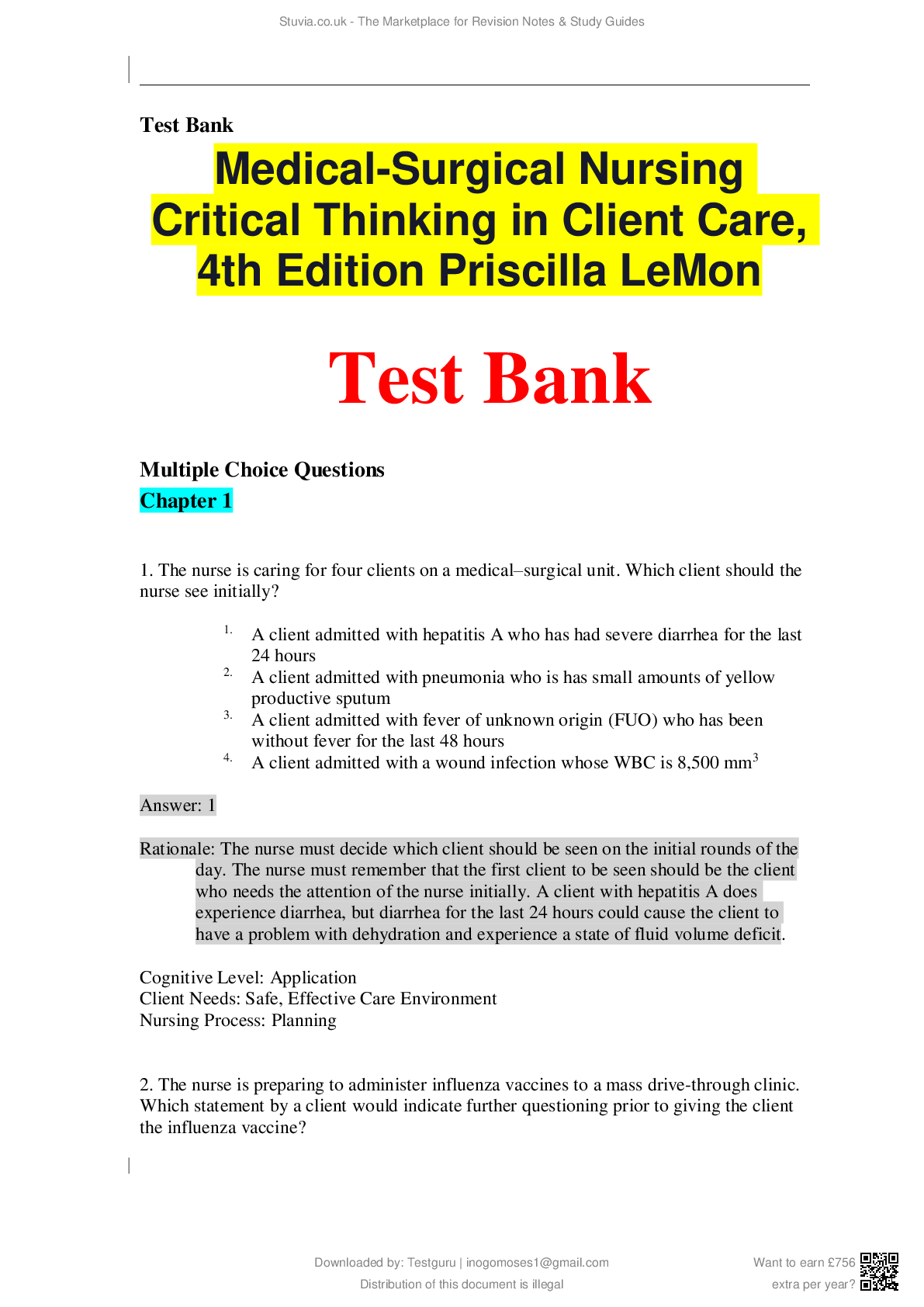*NURSING > TEST BANKS > INTRODUCTION TO NURSING THEORIES (All)
INTRODUCTION TO NURSING THEORIES
Document Content and Description Below
INTRODUCTION Nursing has made phenomenal achievement in the last century that has lead to the recognition of nursing as an academic discipline and a profession. A move towards theory-based practice... has made contemporary nursing more meaningful and significant by shifting nursing’s focus from vocation to an organised profession. The need for knowledge-base to guide professional nursing practice had been realised in the first half of the twentieth century and many theoretical works have been contributed by nurses ever since, first with the goal of making nursing a recognised profession and later with the goal of delivering care to patients as professionals. A theory is a group of related concepts that propose action that guide practice. A nursing theory is a set of concepts, definitions, relationships, and assumptions or propositions derived from nursing models or from other disciplines and project a purposive, systematic view of phenomena by designing specific interrelationships among concepts for the purposes of describing, explaining, predicting, and /or prescribing.. Based on the knowledge structure levels the theoretical works in nursing can be studied under the following headings: • Metaparadigm (Person, Environment, Health & Nursing) – (Most abstract) • Nursing philosophies. • Conceptual models and Grand theories. • Nursing theories and Middle range theories (Least abstract) NURSING PHILOSOPHIES Theory Key emphasis Florence Nightingale’s Legacy of caring Focuses on nursing and the patient environment relationship. Ernestine Wiedenbach: The helping art of clinical nursing Helping process meets needs through the art of individualizing care. Nurses should identify patients ‘need-for – help’ by: Observation Understanding client behaviour Identifying cause of discomfort Determining if clients can resolve problems or have a need for help Virginia Henderson’s Definition of Nursing Patients require help towards achieving independence. Derived a definition of nursing Identified 14 basic human needs on which nursing care is based. Faye G.Abedellah’s Typology of twenty one Nursing problems Patient’s problems determine nursing care Lydia E. Hall :Care, Cure, Core model Nursing care is person directed towards self love. Jean Watson’s Philosophy and Science of caring Caring is moral ideal: mind -body – soul engagement with one and other. Caring is a universal, social phenomenon that is only effective when practiced interpersonally considering humanistic aspects and caring. Patricia Benner’s Primacy of caring Caring is central to the essence of nursing. It sets up what matters, enabling connection and concern. It creates possibility for mutual helpfulness. Caring creates - possibilities of coping possibilities for connecting with and concern for others, possibilities for giving and receiving help Described systematically five stages of skill acquisition in nursing practice – novice, advanced beginner, competent, proficient and expert. CONCEPTUAL MODELS AND GRAND THEORIES Dorothea E. Orem’s Self care deficit theory in nursing Self–care maintains wholeness. Three Theories: Theory of Self-Care Theory of Self-Care Deficit Theory of Nursing Systems Wholly compensatory (doing for the patient) Partly compensatory (helping the patient do for himself or herself) Supportive- educative (Helping patient to learn self care and emphasizing on the importance of nurses’ role Myra Estrin Levine’s: The conservation model Holism is maintained by conserving integrity Proposed that the nurses use the principles of conservation of: Client Energy Personal integrity Structural integrity Social integrity A conceptual model with three nursing theories – Conservation Redundancy Therapeutic intention Martha E.Roger’s: Science of unitary human beings Person environment are energy fields that evolve negentropically Martha proposed that nursing was a basic scientific discipline Nursing is using knowledge for human betterment. The unique focus of nursing is on the unitary or irreducible human being and the environment (both are energy fields) rather than health and illness Dorothy E.Johnson’s Behavioural system model Individuals maintain stability and balance through adjustments and adaptation to the forces that impinges them. Individual as a behavioural system is composed of seven subsystems. Attachment, or the affiliative subsystems – is the corner stone of social organisations. Behavioural system also includes the subsystems of dependency, achievement, aggressive, ingestive-eliminative and sexual. Disturbances in these causes nursing problems. Sister Callista: Roy‘s Adaptation model Stimuli disrupt an adaptive system The individual is a biopsychosocial adaptive system within an environment. The individual and the environment provide three classes of stimuli-the focal, residual and contextual. Through two adaptive mechanisms, regulator and cognator, an individual demonstrates adaptive responses or ineffective responses requiring nursing interventions Betty Neuman’s : Health care systems model Reconstitution is a status of adaptation to stressors A conceptual model with two theories “Optimal patient stability and prevention as intervention” Neuman’s model includes intrapersonal, interpersonal and extrapersonal stressors. Nursing is concerned with the whole person. Nursing actions (Primary, Secondary, and Tertiary levels of prevention) focuses on the variables affecting the client’s response to stressors. Imogene King’s Goal attainment theory Transactions provide a frame of reference toward goal setting. A conceptual model of nursing from which theory of goal attainment is derived. From her major concepts (interaction, perception, communication, transaction, role, stress, growth and development) derived goal attainment theory. · Perceptions, Judgments and actions of the patient and the nurse lead to reaction, interaction, and transaction (Process of nursing). Nancy Roper, WW.Logan and A.J.Tierney A model for nursing based on a model of living Individuality in living. A conceptual model of nursing from which theory of goal attainment is derived. Living is an amalgam of activities of living (ALs). Most individuals experience significant life events which can affect ALs causing actual and potential problems. This affects dependence – independence continuum which is bi-directional. Nursing helps to maintain the individuality of person by preventing potential problems, solving actual problems and helping to cope. Hildegard E. Peplau: Psychodynamic Nursing Theory Interpersonal process is maturing force for personality. Stressed the importance of nurses’ ability to understand own behaviour to help others identify perceived difficulties. The four phases of nurse-patient relationships are: 1. Orientation 2. Identification 3. Exploitations 4. Resolution The six nursing roles are: 1. Stranger 2. Resource person 3. Teacher 4. Leader 5. Surrogate 6. Counselor Ida Jean Orlando’s Nursing Process Theory Interpersonal process alleviates distress. Nurses must stay connected to patients and assure that patients get what they need, focused on patient’s verbal and non verbal expressions of need and nurse’s reactions to patient’s behaviour to alleviate distress. Elements of nursing situation: 1. Patient 2. Nurse reactions 3. Nursing actions Joyce Travelbee’s Human To Human Relationship Model Therapeutic human relationships. Nursing is accomplished through human to human relationships that began with: The original encounter and then progressed through stages of Emerging identities Developing feelings of empathy and sympathy, until the nurse and patient attained rapport in the final stage. Kathryn E. Barnard’s Parent Child Interaction Model Growth and development of children and mother–infant relationships Individual characteristics of each member influence the parent–infant system and adaptive behaviour modifies those characteristics to meet the needs of the system. Ramona T.Mercer’s :Maternal Role Attainment Parenting and maternal role attainment in diverse populations A complex theory to explain the factors impacting the development of maternal role over time. Katharine Kolcaba’s Theory of comfort Comfort is desirable holistic outcome of care. Health care needs are needs for comfort, arising from stressful health care situations that cannot be met by recipients’ traditional support system. These needs include physical, psycho spiritual, social and environmental needs. Comfort measures include those nursing interventions designed to address the specific comfort needs. Madeleine Leininger’s Transcultural nursing, culture-care theory Caring is universal and varies transculturally. Major concepts include care, caring, culture, cultural values and cultural variations Caring serves to ameliorate or improve human conditions and life base. Care is the essence and the dominant, distinctive and unifying feature of nursing Rosemarie Rizzo Parse’s :Theory of human becoming Indivisible beings and environment co-create health. A theory of nursing derived from Roger’s conceptual model. Clients are open, mutual and in constant interaction with environment. The nurse assists the client in interaction with the environment and co creating h [Show More]
Last updated: 2 years ago
Preview 1 out of 271 pages

Buy this document to get the full access instantly
Instant Download Access after purchase
Buy NowInstant download
We Accept:

Reviews( 0 )
$13.50
Can't find what you want? Try our AI powered Search
Document information
Connected school, study & course
About the document
Uploaded On
Aug 28, 2021
Number of pages
271
Written in
Additional information
This document has been written for:
Uploaded
Aug 28, 2021
Downloads
0
Views
105

























